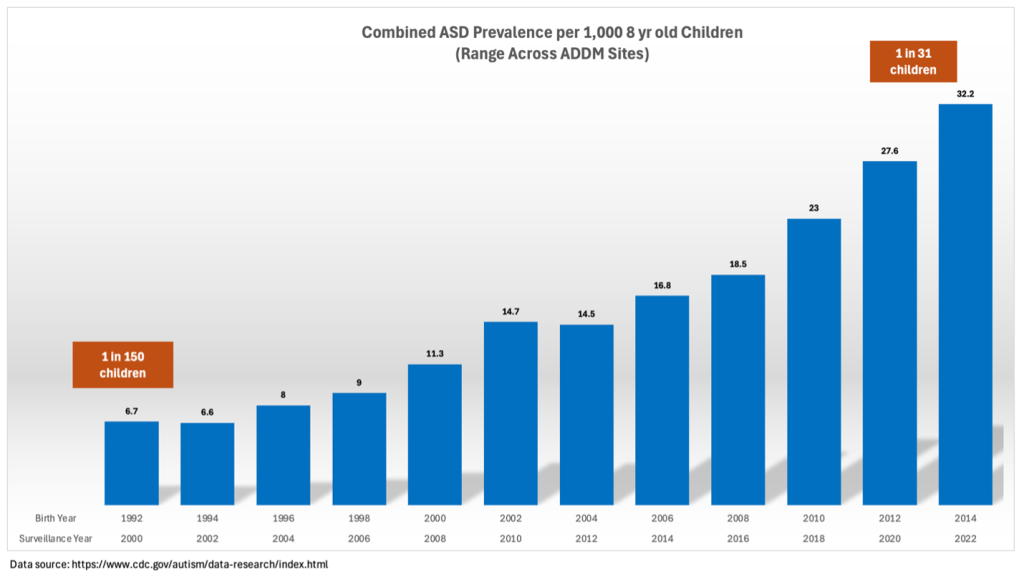Robert F. Kennedy Jr. has called attention to skyrocketing autism rates, launching new HHS research into environmental triggers.
Listen to the audio version of this article:
THE TOPLINE
- At a recent press conference, Robert F. Kennedy Jr. highlighted the sharp rise in autism rates and announced new HHS-led research initiatives aimed at identifying environmental contributors to autism spectrum disorder (ASD), moving beyond the prevailing belief that rising diagnoses are due solely to increased awareness.
- The new research will examine potential environmental drivers—such as pollutants, food additives, and indoor toxins—alongside genetic vulnerabilities, emphasizing ASD’s complex, multifactorial nature and the need for deeper, independent investigation.
In a recent press conference, Robert F. Kennedy Jr. spotlighted the staggering rise in autism spectrum disorder (ASD) rates across the United States and announced a series of new federally-backed studies aimed at uncovering the environmental factors that may contribute to this complex neurodevelopmental condition.
Kennedy directly challenged the long-standing view that the explosion in ASD rates is primarily the result of improved diagnostic criteria or increased awareness. He pointed to historic prevalence rates—from as low as 1 in 10,000 children in Wisconsin several decades ago to today’s estimate of 1 in 31 (see Figure below)—as evidence that this shift cannot be fully explained by changes in how ASD is diagnosed.

Kennedy noted that dismissing this rise as an artefact of diagnostic expansion prevents serious examination of possible environmental causes—and shields industries that are polluting our environment and kids’ bodies from accountability. He highlighted a study from the UC Davis M.I.N.D. Institute, which concluded that the 700% increase in ASD prevalence since 1990 in California could not be explained by changes in diagnosis or classification alone, which the authors estimated accounted for a relatively small percentage of the increase. About 56% of the increase was attributable to inclusion of milder cases of ASD; 24% of the increase could be attributed to earlier age at diagnosis. That leaves a 620% increase unaccounted for.
A Focus on Environmental Toxins
While avoiding discussion of vaccines entirely, Kennedy kept the focus on environmental toxins as key drivers of ASD risk. Kennedy noted that while genetics can create a vulnerability to ASD—by, for example, creating low glutathione levels or methylation challenges—it is likely environmental exposures that serve as the triggering factor. The newly announced HHS research efforts will investigate a wide range of potential contributors, including mold and indoor environmental exposures, food additives and preservatives, air and water pollution, and maternal/paternal age as well as pre-existing conditions such as obesity and diabetes.
This approach reflects a growing understanding that ASD is unlikely to stem from a single cause. Rather, it emerges from a complex interaction between genetic susceptibility and environmental influences during critical developmental windows.
It is critical that Kennedy and his team look at the effects of our total burden from the growing number of new-to-nature chemicals and radiation sources to which we are all exposed via all routes of exposures (ingestion, inhalation and dermal [skin]). Looking at one potential trigger or causative agent at a time will miss the dangers posed by the additive and cumulative effect of all these diverse exposures on human health. We must also recognize that infants and children are among the most vulnerable to such exposures, and total burden of exposure today is order of magnitudes different to, say, what it was for the boomer generation.
The High Cost of Inaction
Kennedy emphasized the societal and economic burden of ASD. He said that by 2035, the cost of managing ASD in the US could surpass $1 trillion annually. These costs encompass far more than just medical care. Children with ASD—especially the 26.7% of autistic children with profound autism—often require intensive, lifelong support. It’s no surprise then, that families of children with ASD face:
- Increased healthcare usage, including more frequent visits to primary care and mental health services; this also includes treatment for common co-occurring conditions like epilepsy, anxiety, ADHD, and sleep disorders
- High out-of-pocket costs for therapies, specialized education, and respite care
- Substantial indirect costs, particularly lost productivity as parents reduce or leave employment to care for their children
These challenges have profound implications not only for affected individuals but also for family well-being, economic security, and mental health.
Backlash
ASD is an emotional and difficult topic, and there has been significant pushback against Kennedy’s remarks from disability rights activists.

It is critical to strike the right balance that respects the lived experiences and rights of individuals with ASD, as well as the families and communities that manage them. But one might respectfully argue that investigating the underlying causes of ASD so that meaningful steps can be taken to prevent it—particularly in its most severe forms—is not inherently in conflict with supporting the dignity and autonomy of those who are already living with the condition.
Public health policy must be able to hold two truths at once: that individuals with ASD, including those with high support needs, deserve full inclusion, respect, and opportunity; and that it is also reasonable to seek answers about why ASD rates are rising so dramatically.
Transparency and Privacy Questions Linger
As part of the federal government’s new push to investigate environmental factors contributing to ASD, the National Institutes of Health (NIH) is assembling a vast new dataset of private medical records to support the initiative. This dataset will reportedly provide “comprehensive” and “broad coverage” of the US population, offering researchers access to unprecedented levels of health information from both public and private sources.
The data will come from a wide array of systems, including medication records from pharmacy chains, lab testing and genomics data from the Department of Veterans Affairs and Indian Health Service, claims data from private insurers, and information collected from wearable fitness trackers and smartwatches.

This consolidation of data marks a bold new approach to understanding ASD. But it also raises important concerns about transparency, consent, and data security. While NIH Director Dr. Jay Bhattacharya emphasized that researchers will not be able to download the data and that “state of the art protections” will be in place to protect confidentiality, many critical questions remain unanswered:
- Will the data be truly anonymous, or could it be re-identified through cross-referencing?
- Will individuals be able to opt out of having their data used in these studies?
- Which specific datasets and commercial partners are involved in providing this sensitive information?
- What oversight mechanisms will ensure the ethical use of this data?
The scale and ambition of the new research effort are significant—and so is the responsibility to uphold the trust of the public, particularly given RFK’s pledge of “radical transparency.” As this initiative unfolds, transparency about how data is gathered, used, and protected will be essential to its legitimacy and ethical grounding.
Moving Toward Answers
At ANH-USA, we believe that uncovering the underlying causes and drivers of ASD is essential if we’re to find better solutions by those already affected as well as for prevention and a reduction in the escalating prevalence. ASD is a undeniably a complex, multifactorial condition. Understanding the web of causation requires honest, independent research unencumbered by industry influence.
We applaud efforts to shine a light on environmental risks that have long been overlooked and to push for public health policy grounded in science, transparency, and a commitment to the well-being of future generations.
Please share this article widely among your networks.





More and more parents are fighting to get their children on the spectrum . Years ago you were autistic or not no spectrum. That is why more children are being label then in the pay . You had to meet all the markers 21 of them to be autistic now if you touch on a few you are on the spectrum. Let’s go back to no one one the spectrum and the numbers will go down drastically.
Interesting how the elephant in the room is never mentioned: Electromagnetic radiation from cell phones, baby monitors, cell towers, and so on!
I frequently see pregnant women or mothers with babies in a front carrier using cellphones close to the abdomen or infant.
And what about wireless baby monitors? Cell phones as toys for toddlers? It never ends!
It needs to be investigated. Scientists and doctors have known for a long time that the radiation penetrates the young brain more easily and deeply than the brain of adults. Doesn’t this suggest possible danger?
Over 5% of adults are severely handicapped by EMR according to more than a thousand peer reviewed studies. Can we still pretend it won’t affect the unborn or young children?
Where is the genetic testing as step 1 in this conversation? If environmental causes are at play, proteins would be impacted which presents through DNA and RNA testing. Why isn’t this article and every other aspect of the strategy to find a root cause not starting with genetic testing to see what has changed at the cellular/molecular level. The environment is changing proteins and/or protein interactions so START there rather than violating privacy by stealing medical records without consent.
Kennedy is wise to avoid mentioning vaccines in his discussions. This avoids the immediate wrath of big pharma. He should then quietly include vaccines in the study. When the results of the study show that vaccines can and do cause autism, big pharma will be forced to explain the cover up.